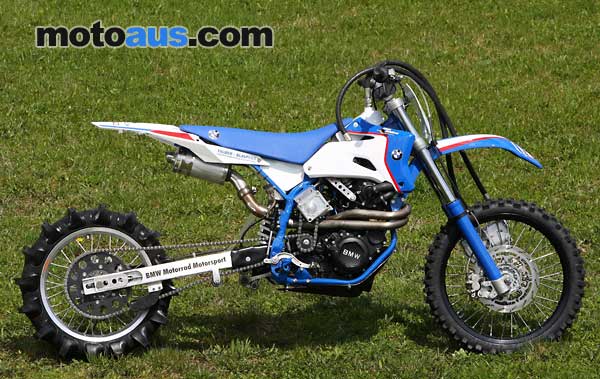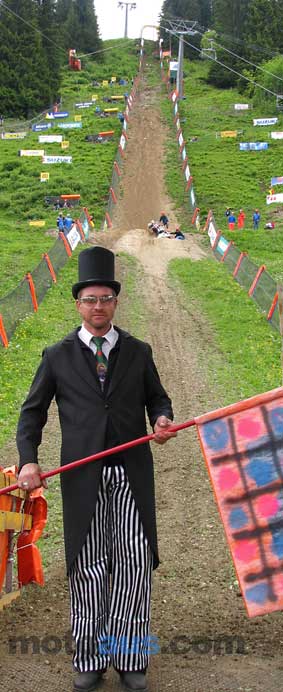 Silvio Schölzel has finished a credible fourth place at the recent European Hillclimbing Championship event at Obersaxen in Switzerland
Silvio Schölzel has finished a credible fourth place at the recent European Hillclimbing Championship event at Obersaxen in Switzerland

Two Wheel Drive Hillclimber
Owner of the trick two wheel drive F800 hillclimb machine Silvio Schölzel has finished a credible fourth place at the recent European Hillclimbing Championship event at Obersaxen in Switzerland after Chris Pfeiffer had to withdraw from riding with an injury.
Pfeiffer had been planning to compete on the custom-built, two-wheel drive F 800-powered hillclimbing bike, but an injury sustained while attempting a back-flip, meant that the German had to withdraw from the event. Therefore, it was down to Silvio Schölzel to pilot his own specially constructed BMW F 800-powered machine up the notoriously steep Karitscha Hill.
 When the snow melts, the popular ski resort of Obersaxen is transformed into a haven for those seeking thrills of a two-wheeled nature. The steep hills and exposed terrain serve as a perfect venue for the ever-popular sport of hillclimbing. Every year, many of the world’s most talented motorcycle ‘climbers’ arrive on the hills of Obersaxen with only one vision: to get as high up the Karitscha Hill as possible without falling off their bikes.
When the snow melts, the popular ski resort of Obersaxen is transformed into a haven for those seeking thrills of a two-wheeled nature. The steep hills and exposed terrain serve as a perfect venue for the ever-popular sport of hillclimbing. Every year, many of the world’s most talented motorcycle ‘climbers’ arrive on the hills of Obersaxen with only one vision: to get as high up the Karitscha Hill as possible without falling off their bikes.
Although this sounds like a relatively simple process, the reality is far more difficult. The 235-metre long course rises by an incredible 115 metres from start to finish, meaning that in some areas the gradient can reach 140 per cent. Most people would find crawling up the hill on their hands and knees difficult enough, but to maintain balance and motion on two wheels takes extraordinary talent.
One man who knows the intricacies of Obersaxen is Chris Pfeiffer. The 38-year-old has competed there twice, both times taking a BMW HP2 Enduro to dizzying heights by finishing on the podium. He was ruled out of the 2008 event due to injury, but gave an insight as to what it takes to be successful at the European Hillclimbing Championship.
“On the upper section of the course there’s no good line so grip is really at a premium,” says Chris. “It’s vitally important to carry your speed right to the top and to try and accelerate over the steeper sections. In terms of riding style, you don’t need to treat it as a trials event by standing on the footpegs, instead you need to be seated and leaning forward to maintain balance and optimum grip traction.”
With Pfeiffer absent, Silvio Schölzel carried the flag for BMW Motorrad, aboard a modified BMW F 800-powered machine in the Open class. With extended swingarms and custom tyres, the bikes in the Open class are built-for-purpose to ensure the maximum distance is covered. In difficult wet conditions, Schölzel finished in fourth position, on his first outing on the F 800-derived machine.
“The Obersaxen event is very difficult because the hill is so steep and very high,” says Silvio. “The ground is also very loose and you have to find your own line. Often in hillclimbing, there is a path carved out by previous competitors, however at Obersaxen, this line disappears the further you travel up the hill. I was satisfied with my performance, particularly because it was the first time that I had ridden the BMW F 800 in competition. It’s a very nice bike – much lighter than I anticipated it would be – and it has a lot of power, which is one of the most important attributes a bike can have in hillclimbing. But most importantly, it covers up any little rider errors from me!”

Schölzel ultimately registered a distance of 191.6 metres in the final, bettering his qualification distance of 161.1 metres. The German-born rider was almost 40 metres clear of fifth placed rider Christian Müller and just 7.3 metres away from third position and a podium finish.
The winner of the event, hillclimbing legend Lars Nonn was the only rider to achieve a distance of 200m, in what were the most difficult conditions seen at Obersaxen in recent years.
